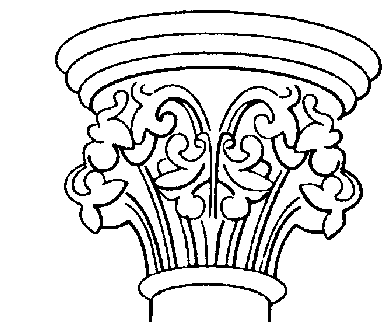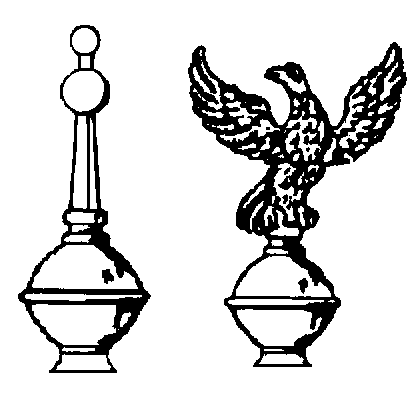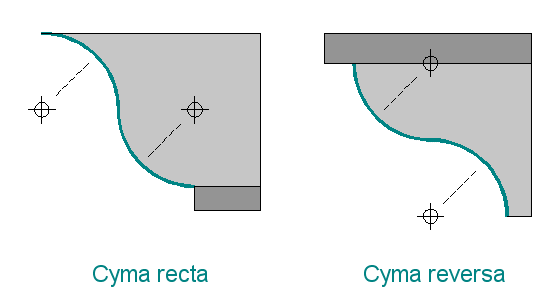APPENDIX VII. Architectural and ecclesiastical terms used in dialling
The following terms, taken from the field of architecture (Fleming et al) have been adapted to describe architectural features found in dialling. Parts of a church are also included as they are frequently used to describe the location of a dial. Figure 6. Component parts of a pedestal abacus: the flat slab on the top of a capital, for example, immediately under a horizontal dial on a pedestal. aisle: the part(s) of a church running alongside the central nave. There is often a north and a south aisle, and they are usually of lesser height than the nave. apophyge: the slight curve at the top and bottom of a column where it joins the capital or base. apse: large semicircular or polygonal recess, arched or dome-roofed, at the end of a church. baluster: an architectural term for the short pillars which form the supports for a balustrade. The term can be used in dialling to describe the common variety of shaft for apedestal which is bulbous towards the bottom and rises to a neck of smaller diameter, similar to that shown in Figure 6. banded shaft: (or blocked shaft) a column broken by plain or rusticated blocks of stone. base: part of a pedestal for a dial, it stands on the plinth and supports the column. buttress: a mass of masonry or brickwork projecting from or built against a wall to give additional strength. capital: the head or crowning feature of a column. Many stylised forms exist and have special names. 
Figure7. A stiff leaf capital caryatid: strictly, a sculptured female figure used as a column to support a dial, etc. It can be used more loosely for other human figures, e.g. Atlantes (male caryatids), Herms(three-quarter-length figures), and Terms (tapering columns merging at the top into human, animal or mythical figures). chamfer: the surface made when the sharp edge (arris) of a stone block is cut away, usually at an angle of 45º to the other two surfaces. It is called a hollow chamfer when the surface is made concave. chancel: a part of a church, at its east end and near the altar, reserved for the clergy, choir, etc. clerestory: part of a wall of a cathedral or large church, with a series of window, above aisle roofs. column: in classical architecture, it is a part of an Order, comprising the capital, shaft and base and is circular or square in cross-section.. This definition can also be adopted for dialling purposes. compound column: a column comprising a number of merged or semi-merged shafts. corbel: a projecting block, usually of stone, inserted into a wall to support, for example, a vertical dial. crown: a decoration over the top of a vertical dial as an alternative to a pediment. entablature: the upper part of an Order, made up of architrave, frieze, cornice etc. Loosely, everything above the capital. finial: a formal pointed ornament on top of a canopy, gable etc. It is sometimes seen on top of a pillar dial, often in the from of a ball-and-spire or a fleur-de-lis. 
Figure 8. Ball and Eagle finials flute: a semicircular vertical groove in a pillar. foliated: carved with a leaf ornament. helix: a spiral motif, especially on a shaft or column. moulding: a continuous ornamental band around a shaft, column, capital etc. There are many specially named types. 
Figure 9. Ogee and reverse-ogee mouldings nave: the body of a church, especially from the west door to the chancel and usually separated from the aisles by pillars. obelisk: a tall tapering shaft of stone, usually monolithic with a square or rectangular section ending with a pyramidal apex. Prominent in Ancient Egypt as a solar symbol, often at the entrance to tombs or as a cult object in shrines to the sun. Order: in classical architecture, a term used to describe a column with its base, shaft, capital and entablature, designed in one of a number of accepted modes, for example Doric or Ionic. The component description of these Orders have been adapted for dialling purposes. pedestal: the term adopted by diallists to describe the whole structure, usually of stone, used to support a dial (most usually horizontal). See Figure 6. pediment: a low-pitched gable, sometimes seen over the top of vertical dials. It may be open at the apex, in which case it is termed a broken-apex ~ or sometimes just a broken pediment. Versions with curved segments are called swan-neck ~. 
Figure 10. Swan and broken pediments pillar: similar to the classical column, but need not have the simple circular or square cross section. plinth: the bottom part of a pedestal, either in direct contact with the ground or with the general horizontal surface. It is often chamfered or with a moulding around it. Priest’s door: a door on the south-side of the chancel of a church, used by the clergy. Its surround is a common site for mass dials. shaft: the trunk of a classical column, between the base and capital. It may be used more loosely in dialling to describe the similar section of a pedestal. solarium: a sun terrace or loggia. spandrel: an architectural term for the space between the shoulder of an arch and the surrounding rectangular brickwork. In dialling, the term can be used to describe the corner areas of a square dial plate with a circular chapter ring. transept: the transverse arms of a cross-shaped church, usually between the nave and the chancel, but occasionally at the west end of the nave as well. |